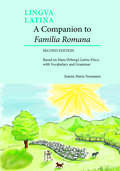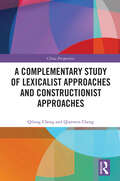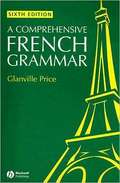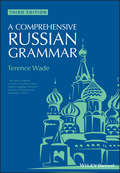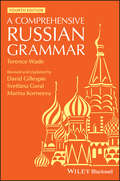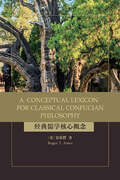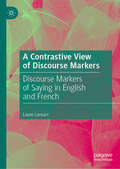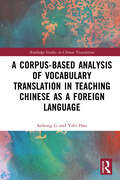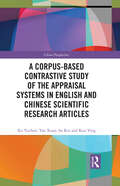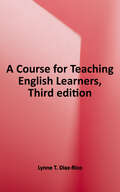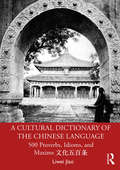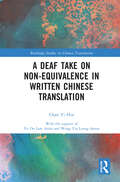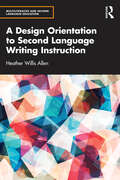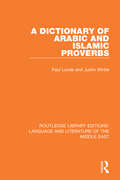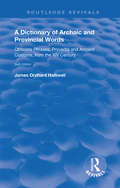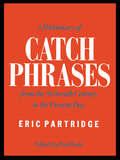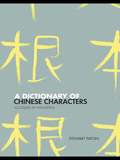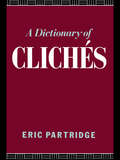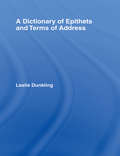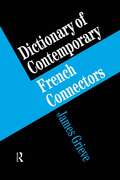- Table View
- List View
A Companion to Familia Romana: Based on Hans Ørberg's Latine Disco, with Vocabulary and Grammar
by Jeanne Neumann Hans H. ØrbergThis volume is the completely reset Second Edition of Jeanne Marie Neumann's A College Companion (Focus, 2008). It offers a running exposition, in English, of the Latin grammar covered in Hans H. Ørberg's Familia Romana, and includes the complete text of the Ørberg ancillaries Grammatica Latina and Latin–English Vocabulary. It also serves as a substitute for Ørberg's Latine Disco, on which it is based. As it includes no exercises, however, it is not a substitute for the Ørberg ancillary Exercitia Latina I. Though designed especially for those approaching Familia Romana at an accelerated pace, this volume will be useful to anyone seeking an explicit layout of Familia Romana's inductively-presented grammar. In addition to many revisions of the text, the Second Edition also includes new units on cultural context, tied to the narrative content of the chapter.
A Companion to Roma Aeterna: Based on Hans Ørberg's Instructions, with Vocabulary and Grammar
by Jeanne Neumann Hans H. ØrbergA sequel to her widely used A Companion to Familia Romana (now in its second edition), Jeanne Marie Neumann's A Companion to Roma Aeterna offers a running commentary, in English, of the Latin grammar covered in Hans H. Ørberg's Roma Aeterna, and includes the complete text of the Ørberg ancillaries Grammatica Latina and Latin–English Vocabulary II. It also serves as a substitute for Ørberg’s Instructions, on which it is based. Though designed especially for those approaching Roma Aeterna at an accelerated pace, this volume will be useful to anyone seeking an explicit exposition of that volume's implicitly presented grammar. In addition to many revisions of the text, A Companion to Roma Aeterna also includes new units on cultural context, tied to the narrative content of the chapter.
A Complementary Study of Lexicalist Approaches and Constructionist Approaches (China Perspectives)
by Qilong Cheng Qianwen ChengThis book presents a complementary study of lexicalist approaches and constructionist approaches in linguistics. Specifi c topics discussed include different versions of semantic roles, predicate decomposition, event structures, argument realizations, and cognitive construction grammars. For decades, the relationship between certain concepts and constructions along with related issues of verb-construction associations have been perennially taxing for both lexicalist and constructionist approaches alike. Indeed, in Chinese, unmatched verb-construction associations and the much richer alternate realizations pose very diffi cult problems. Based on a comparative study, the authors make an attempt to account for the possible correspondence between the delicacy of argument setting and the principles of their realization. They also account for the integration of construction with verbs in terms of their coherent conceptual content. The resultant newly developed model throws new light on these thorny Chinese problems. The book will appeal to scholars and students studying cognitive linguistics, cognitive semantics, computational linguistics, and also natural language processing. The book also brings up some new analysis of Chinese data for both researchers and learners of Modern Chinese.
A Comprehensive French Grammar (Blackwell Reference Grammars)
by Glanville PriceCharacterized by clear and accessible explanations, numerous examples and sample sentences, a new section on register and tone, and useful appendices covering topics including age and time, A Comprehensive French Grammar, Sixth Edition is an indispensable tool for advanced students of French language and literature. A revised edition of this established, bestselling French grammar Includes a new section on register and medium and offers expanded treatment of French punctuation Features numerous examples and sample sentences, and useful appendices covering topics including age, time, and dimension, all available in an easily-navigable format Written by renowned French scholar, Glanville Price
A Comprehensive Russian Grammar
by David Gillespie Terence WadeThe third edition of Terence Wade's A Comprehensive Russian Grammar, newly updated and revised, offers the definitive guide to current Russian usage. Provides the most complete, accurate and authoritative English language reference grammar of Russian available on the marketIncludes up-to-date material from a wide range of literary and non-literary sources, including Russian government websitesFeatures a comprehensive approach to grammar expositionRetains the accessible yet comprehensive coverage of the previous edition while adding updated examples and illustrations, as well as insights into several new developments in Russian language usage since the collapse of the Soviet Union in 1991
A Comprehensive Russian Grammar (Blackwell Reference Grammars #12)
by Terence WadeThe most comprehensive guide to Russian usage, fully revised and updated. A Comprehensive Russian Grammar, by Terence Wade, is the definitive resource on Russian usage, providing complete and accurate guidance for students and professionals alike. Now in its fourth edition, this authoritative text continues to be an indispensable reference for English-speaking learners of Russian. Detailed yet accessible chapters cover the essential rules of the Russian language, placing emphasis on the nuances and problems that English speakers find especially difficult. Thoroughly revised and updated by Russian language experts David Gillespie, Svetlana Gural, and Marina Korneeva, this edition reflects changes in the grammar, the lexis, and the contemporary practice of the language in Russia’s increasingly globalized, market-oriented economy. New content includes coverage of words and phrases from IT and social network terminology that have entered the Russian language, original contributions by leading Russian language scholars, and numerous modern usage examples taken from Russian websites, social media, and post-Soviet literature. The standard Russian language reference for English speakers for more than a quarter of a century, this volume: Provides a comprehensive, user-friendly approach to Russian grammar exposition Covers every essential aspect of the Russian language, including prepositions, conjunctions, numerals, and word order Features updated examples and illustrations, new insights into recent developments in Russian language usage, and more consistent transliteration of Russian names Includes a glossary of grammatical terms, word and subject indexes, and a complete bibliography Part of the successful Blackwell Reference Grammars series, A Comprehensive Russian Grammar, Fourth Edition is the ideal guide and reference text for students and teachers of Russian across the English-speaking world, as well as professionals with knowledge of Russian seeking to keep pace with recent changes in the language.
A Conceptual Lexicon for Classical Confucian Philosophy (SUNY series in Chinese Philosophy and Culture)
by Roger T. AmesUses a comparative hermeneutical method to explain the most important terms in the classical Confucian philosophical texts, in an effort to allow the tradition to speak on its own terms.Over the years, Roger T. Ames and his collaborators have consistently argued for a processual understanding of Chinese natural cosmology made explicit in the Book of Changes. It is this way of thinking, captured in its own interpretive context with the expression "continuities in change" (biantong) that has shaped the grammar of the Chinese language and informs the key philosophical vocabulary of Confucian philosophy. Over the past several centuries of cultural encounter, the formula established by the early missionaries for the translation of classical Chinese texts into Western languages has resulted in a Christian conversion of Confucian texts that is still very much with us today. And more recently, the invention of a new Chinese language to synchronize East Asian cultures with Western modernity has become another obstacle in our reading of the Confucian canons. This volume, a companion volume to A Sourcebook in Classical Confucian Philosophy, employs a comparative hermeneutical method in an attempt to explain the Confucian terms of art and to take the Confucian tradition on its own terms.
A Concise Dictionary of Old Icelandic
by Geir T. ZoëgaModern Icelandic is closer to the speech patterns of the Middle Ages than any living European language. Thus, a knowledge of Icelandic is highly relevant to the study of English history. This volume, one of the most complete available, will be indispensable to scholars of medieval Icelandic and English culture and history.
A Contar Amabilidad: Diez formas de darles la bienvenida a niños refugiados
by Hollis KurmanA compassionate counting book that captures the power of a welcoming community.Teach children about refugees and how each kindness can help them find a new home. More than half of the world's refugees are children fleeing scary situations in search of a safe place to live.Arriving in a new place is stressful for newcomers, especially when the newcomers are little ones. But this beautiful counting book helps readers see the journey of finding a new home and the joys of being welcomed into a new community. From playing to sleeping, eating to reading, celebrating to learning, Counting Kindness proves we can lift the heaviest hearts when we come together.
A Contrastive View of Discourse Markers: Discourse Markers of Saying in English and French
by Laure LansariThis book is a comparative corpus-based study of discourse markers based on verbs of saying in English and French. Based on a wide comparable web corpus, the book investigates how discourse markers work in discourse, and compares their differences of position, scope and collocations both cross-linguistically and within single languages. The author positions this study within the wider epistemological background of the French-speaking ‘enunciative’ tradition and the English-speaking ‘pragmatic’ tradition, and it will be of particular interest to students and scholars of semantics, pragmatics and contrastive linguistics.
A Corpus-based Analysis of Vocabulary Translation in Teaching Chinese as a Foreign Language (Routledge Studies in Chinese Translation)
by Saihong Li Yifei HaoThis monograph investigates the landscape of vocabulary translation challenges within Teaching Chinese as a Foreign Language (T.C.F.L.) textbooks. In the era of globalisation, where the demand for Chinese language proficiency has escalated due to cultural exchanges, economic collaborations, tourism, and overseas learning, this study examines the accuracy and effectiveness of vocabulary translations in T.C.F.L. textbooks. The authors adopt an innovative approach, centring on analysing audience responses, including feedback from teaching practitioners and learners of Chinese languages and utilising corpus-based data to evaluate the consistency and appropriateness of vocabulary translations. This book is an essential resource for scholars and educators, as well as students in education, Chinese studies, translation studies, and language learning.
A Corpus-based Contrastive Study of the Appraisal Systems in English and Chinese Scientific Research Articles (China Perspectives)
by Xu Yuchen Yan Xuan Su Rui Kou YingAppraisal is the way language users express their attitude towards things, people, behaviour or ideas. In the last few decades, significant achievements have been made in Appraisal Theory research, yet little attention has been paid to appraisal in scientific texts, especially in relation to the contrast to how it is applied in English and Chinese. This title examines the similarities and differences of Appraisal systems in English and Chinese scientific research articles. Using a self-constructed corpus of scientific research articles, the authors make cross-linguistic comparisons in terms of the quantity and distribution patterns of categories of appraisals. They creatively categorise articles into theoretical scientific research articles and applied studies and discover that for both languages, each genre can have its own favorite mode of distribution for the realization of appraisal systems. In addition, this research helps appraisal theory systems to become more explicit, specific, and more applicable for the analysis of scientific research articles. Students and scholars of applied linguistics, comparative linguistics and corpus linguistics will find this an essential reference.
A Course for Teaching English Learners
by Lynne T. Diaz-RicoPrinciples and classroom techniques for teaching English language learners A Course for Teaching English Learners combines the fundamental principles of education with practical English language education techniques to help both pre- and in-service educators reach English language students in impactful ways. <p><p>The text provides background in cultural, linguistic, and sociocultural context, building a comprehensive framework for effective English language education. Uniquely, the text outlines both psychological and sociocultural contexts at play at all school levels, including second-language acquisition hurdles and strategies for teaching content subjects. <p><p>The 3rd Edition has been updated with a wealth of new and revised content, including new information on evolving certification requirements, modern demographic data, technology-enhanced language learning, translanguaging, and more.
A Critical Auto/Ethnography of Learning Spanish: Intercultural competence on the gringo trail?
by Phiona StanleyThe premise that intercultural contact produces intercultural competence underpins much rationalization of backpacker tourism and in-country language education. However, if insufficiently problematized, pre-existing constructions of cultural 'otherness' may hinder intercultural competence development. This is nowhere truer than in contexts in which wide disparities of power, wealth, and privilege exist, and where such positionings may go unproblematized. This study contributes to theoretical understandings of how intercultural competence develops through intercultural contact situations through a detailed, multiple case study of three conceptually comparable contexts in which Western backpackers study Spanish in Latin America. This experience, often 'bundled' with home-stay, volunteer work, social, and tourist experiences, offers a rich set of empirical data within which to understand the nature of intercultural competence and the processes through which it may be developed. Models of a single, context-free, transferable intercultural competence are rejected. Instead, suggestions are made as to how educators might help prepare intercultural sojourners by scaffolding their intercultural reflections and problematizing their own intersectional identities and their assumptions. The study is a critical ethnography with elements of autoethnographic reflection. The book therefore also contributes to development of this qualitative research methodology and provides an empirical example of its application.
A Cultural Dictionary of The Chinese Language: 500 Proverbs, Idioms and Maxims 文化五百条
by Liwei JiaoA Cultural Dictionary of the Chinese Language introduces the 500 most important cultural traits of the Chinese as reflected in language use, especially in Chinese idioms (chengyu), proverbs and colloquial expressions (suyu). Communicative competence, the ultimate goal of language learning, consists of not only linguistic, but intercultural competence, which enables the language learner to speak with fluency and understanding. The Chinese language is richly imbued with cultural wisdoms and values underlying the appropriateness of idioms in the Chinese language. The Dictionary provides Intermediate and B1-C1 level learners as well as scholars of the Chinese language with an essential reference book as well as a useful cultural reader.
A Deaf Take on Non-Equivalence in Written Chinese Translation (Routledge Studies in Chinese Translation)
by Chan Yi HinA Deaf Take on Non-Equivalence in Written Chinese Translation examines the issue of lexical non-equivalence between written Chinese and Hong Kong Sign Language (HKSL) translation, describing its theoretical and practical implications. This research foregrounds the semiotic resources in the Deaf community of Hong Kong by analyzing translation strategies exhibited by Deaf Hongkongers when they were invited to translate written Chinese passages with specialized and culturally specific concepts in a monologic setting. With discourse analysis as a framework, the major findings of this research were that: (1) a taxonomy of strategies featured depiction, manual representations of Chinese characters and visual metonymy, writing and mouthing; (2) employment of multisemiotic and multimodal resources gave intended viewers access to different facets of meaning; and (3) repeated renditions of the same concepts gave rise to condensed, abbreviated occasionalisms. Observations from this research serve as a point of reference for interpreting scholars, practitioners and students as well as policymakers who formulate interpretation service provision and assessment.
A Design Orientation to Second Language Writing Instruction (Multiliteracies and Second Language Education)
by Heather Willis AllenA Design Orientation to Second Language Writing Instruction presents the principles of a Design orientation to second language writing and argues for new directions in second language writing instruction.This book elaborates an approach to L2 writing instruction relevant for the diverse multilingual educational contexts and ever-changing literacies of the 21st century. A comprehensive introductory chapter which synthesizes recent history and current challenges in writing instruction for languages other than English is followed by chapters that link theory and practice, articulate principles of Design writing, and provide practical guidance for how instructors can implement Design writing instruction in ways that increase the relevance and value of writing for today's diverse learners.As well as being a valuable resource for researchers of second language acquisition and second language instructors at all levels of instruction, A Design Orientation to Second Language Writing Instruction will also appeal to teacher educators and graduate students.
A Dictionary of Arabic and Islamic Proverbs (Routledge Library Editions: Language And Literature Of The Middle East Ser.)
by Justin Wintle Paul LundeOne of the quickest ways to understand a people or a culture is to learn their proverbs. This anthology, first published in 1984, compiles in dictionary form proverbs from the Islamic world, particularly the Middle East and North Africa. The Arabs were the first to gather and annotate their own proverbs – the earliest collections date from the n
A Dictionary of Archaic and Provincial Words: Obsolete Phrases, Proverbs, and Ancient Customs, from the XIV Century (Routledge Revivals)
by James Orchard HalliwellSo far I may be permitted to speak without intrenching on the limits of criticism. A work containing more than 50,000 words, many of which have never appeared even in scattered glossaries, and illustrated, with very few exceptions, by original authorities, much contain valuable material for the philogist, even if disfigured by errors. With respect to the latter contingency, I am not acquainted with any glossary, comprising merely a few hundred words which does not contain blunders, although in many instances the careful attention of the editor has been specially directed to the task. Can I then anticipate that in a field so vast that no single life would sufice for a minute examination of every object, I could have escaped proportionate liabilities? That such may be pointed out I have little doubt, notwithstanding the pains to prevent their occurrence, but it will be manifestly unfair to make them the test of merit, or thence to pronounce a judgement on the accuracy of the whole.
A Dictionary of Catch Phrases: British and American, from the Sixteenth Century to the Present Day
by Eric PartridgeA catch phrase is a well-known, frequently-used phrase or saying that has `caught on' or become popular over along period of time. It is often witty or philosophical and this Dictionary gathers together over 7,000 such phrases.
A Dictionary of Chinese Characters: Accessed by Phonetics
by Stewart PatonBy arranging frequently used characters under the phonetic element they have in common, rather than only under their radical, the Dictionary encourages the student to link characters according to their phonetic. The system of cross-referencing then allows the student to find easily all the characters in the dictionary which have the same phonetic element, thus helping to fix in the memory the link between a character and its sound and meaning. This innovative resource will be an excellent study-aid for students with a basic grasp of Chinese, whether they are studying with a teacher or learning on their own.
A Dictionary of Cliches
by Eric PartridgeThis work is full of things better left unsaid: hackneyed phrases, idioms battered into senselessness, infuriating Gallicisms, once-familiar quotations and tags from the ancient classics. It makes a formidable list, amplified as it is with definitions, sources, and indications of the clichés, venerability in every case.
A Dictionary of English Surnames
by P. H. Reaney R. M. WilsonThis classic dictionary answers questions such as these and explains the origins of over 16,000 names in current English use. It will be a source of fascination to everyone with an interest in names and their history.
A Dictionary of Epithets and Terms of Address
by Leslie DunklingFirst published in 1990. Routledge is an imprint of Taylor & Francis, an informa company.
A Dictionary of French Connectors
by James GrieveConnecting words and phrases are essential for discussion, clarity and fluency in any language. French is particularly reliant on connecting language: also and in fact have around 15 equivalent words and expressions in French. This is the first French-English dictionary to focus on this fascinating and crucial part of the language. The dictionary presents nearly 200 full entries in alphabetical order, including: de plus; et ce; or; c'est dire que; en fait; au total; voila. Entries define, discuss and exemplify the whole range of connecting language in French. 2000 examples add further clarity and are chosen from a wide range of registers and mainly contemporary prose.
